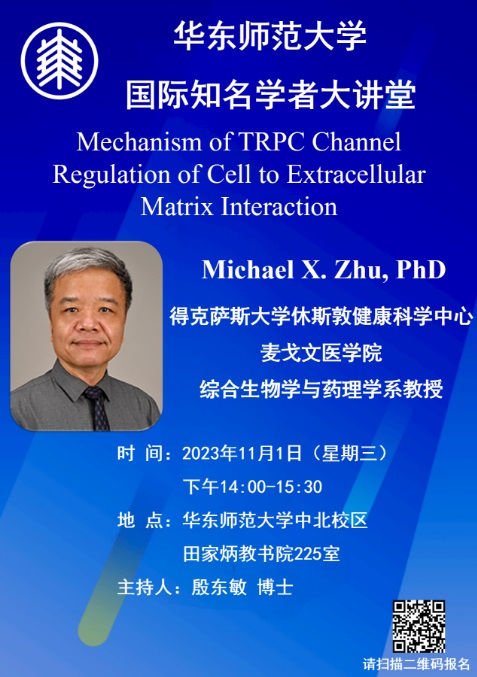报告题目:Mechanism of TRPC Channel Regulation of Cell to Extracellular Matrix Interaction
报 告 人:Michael X. Zhu 教授
主 持 人:殷东敏 博士
报告时间:2023年11月1日下午14:00-15:30
报告地点:华东师范大学中北校区 田家炳教书院225室
报告人简介:
Michael X. Zhu (朱曦) , Michael X. Zhu is professor of Department of Integrative Biology and Pharmacology, McGovern Medical School, The University of Texas Health Science Center at Houston, Houston, Texas. He received his B.S. degree in Biology from Fudan University, Shanghai, China, in 1984, and his M.S. and Ph.D. degrees from University of Houston, Houston, Texas, USA, in 1988 and 1991, respectively. He had his postdoctoral training in Cellular and Molecular Biology from 1991-1994 at Baylor College of Medicine. He then worked as an Assistant Researcher in the Department of Anesthesiology, UCLA, from 1994 to 1997. In autumn of 1997, he went to the Ohio State University to build his own lab and moved from the rank of Assistant Professor to Full Professor in the Department of Neuroscience there. In 2010, he moved to his current position at the University of Texas-Houston. Dr. Zhu’s research interests include several aspects of cell signaling, especially those that involve heterotrimeric G proteins and ion channels that affect Ca2+ signaling. He has published more than 200 research papers, reviews, and monographs on these topics and delivered lectures at many international conferences and symposia. Dr. Zhu’s main contributions include identification and characterization of multiple TRPC channels in mammalian species and determination of the molecular identity of endolysosomal Ca2+ release channels activated by the Ca2+ mobilizing messenger, NAADP.
报告内容:
Transient receptor potential canonical (TRPC) proteins form Ca2+-permeable nonselective cation channels activated downstream from receptors that signal through phospholipase C (PLC). Among the seven mammalian TRPC isoforms, TRPC4 and TRPC5 are unique in that they are also responsive to Gi/o proteins, which allows them to respond to coincident activation of Gq/11-PLC and Gi/o signaling pathways. In addition, TRPC4 channels are subject to dual regulation by phosphatidylinositol 4,5-bisphosphate (PIP2), the substrate of PLC, and cytosolic Ca2+, the product of TRPC4 activation. These ensure that the channel activity is finely tuned to meet the demand of the cellular function. Such a tightly controlled activity should have special attributes to cellular functions that require precise spatiotemporal regulation. However, despite its involvement in various physiological processes, such as endothelial permeability, vascular tone regulation, and synaptic transmission, a unifying cellular function or molecular target that can fully explain the mechanistic underpinnings of TRPC4-dependent physiological activities has not been identified. Moreover, the role of the Ca2+ signal generated by TRPC4 in these physiological activities remains to be fully elucidated. We found that in native cells, TRPC4 is involved in actomyosin activation, integrin function, extracellular matrix protein secretion, and extracellular protein cleavage by sheddases. These activities most likely underlie TRPC4 function under various physiological and disease conditions.



